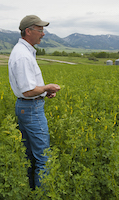We’ve just finished 31 days of commercials, ads, and events – and pink everything – as part of October’s Breast Cancer Awareness Month. And while there doesn’t seem to be a corresponding “Prostate Cancer Awareness Month,” we’re all aware of the threat of cancer – all types of cancer – regardless of our age or gender.

Good cow or bad cow?
(Source: MannyQM)
The World Health Organization’s International Agency for Research on Cancer (IARC) came out with an announcement on October 29 – strategically timed at the end of Breast Cancer Awareness Month? – saying that processed meat has been “classified as carcinogenic to humans” and red meat is “probably carcinogenic to humans.” That announcement launched a perfect storm of confusion and defensiveness for both consumers and producers of meat.
A Google search of “cancer and meat” turns up millions of links, many of which bear titles like: Processed Meats Do Cause Cancer; Can Eating Meat Cause Cancer? Sausages, Ham Cause Cancer; and Eat Meat with Caution?
Claims with this kind of hot-button language may sell newspapers, as they used to say, or “attract eyeballs” in today’s parlance, but they also clearly inflame fear and threaten the livelihood of small ranchers and meat processors. The “big guys” can weather market weaknesses, but smaller operations may not have the resources to stay the course.
Several points of clarification need to be made:
- The report actually indicates that, “For an individual, the risk of developing colorectal cancer because of their consumption of processed meat remains small, but this risk increases with the amount of meat consumed.”
- Regarding the consumption of red meat, the report says that there is “limited evidence that the consumption of red meat causes cancer in humans” based on a positive association observed between the consumption of red meat and cancer. At the same time other explanations for the observations such as chance or some kind of bias could not be ruled out.
- Limiting your consumption of meat – especially factory-farmed and highly processed meats – is a healthy choice, however you do not need to eliminate meat from your diet entirely.
Here’s What You Can Do
- Reduce the amount of meat you consume. North Americans are the second largest consumer of meat in the world, eating about 125 kilograms – that’s slightly over 275 pounds – per person, per year! It’s simple, cut back.

- Eliminate highly processed packaged sandwich and deli meats, and eat those that are minimally processed. Try making your own breakfast sausage patties from ground pork and spices, for example.
- If you want to eat meat, support responsible small and mid-sized organic ranchers who raise pastured meat animals.
Cattle are ruminants (grass eaters) with a complex digestive system evolved to turn plant cellulose into nutritious food. Feedlot cattle are given a corn and grain-based diet that in itself would eventually kill the animals. They are treated with massive amounts of antibiotics and hormones to keep them alive and bring them up to target weight for slaughter.
Organic cattle can be fed a grain-based diet so they face some of the same health problems. The only benefit is that the grain must be organic and the animals must have access to pasture, although they may be temporarily confined for specific reasons.
Know Your Rancher
Grass-farming or raising cattle on a natural diet consisting of fresh grasses, legumes, and other plants and allowing them to roam about is clearly healthier and more humane for the animals; after all, they are ruminants evolved over millennia to eat plants. At the same time, meat from those healthier animals is free of antibiotics, steroids, hormones, pesticides, herbicides, and other potentially toxic substances.


 Combining rotational grazing and using elements of traditional animal husbandry has made it possible for Louis Sukovaty (co-owner of Crown S Ranch, Winthrop WA, with his wife Jennifer Argraves) to raise healthy cattle using organic processes that produce delicious meat entirely on grass and hay, the way cows are supposed to be fed. No grain, no hormones, no antibiotics…
Combining rotational grazing and using elements of traditional animal husbandry has made it possible for Louis Sukovaty (co-owner of Crown S Ranch, Winthrop WA, with his wife Jennifer Argraves) to raise healthy cattle using organic processes that produce delicious meat entirely on grass and hay, the way cows are supposed to be fed. No grain, no hormones, no antibiotics…
Brian Goldhahn, C-5 Organics, produces plump organic, grass-fed Angus beef cattle on 1200 acres of productive clay soils in the Gallatin Valley bordered by the Bridger Mountains, located in west central Montana.
Goldhahn will tell you right out, “I don’t raise beef cattle, I manage a pasture and raise grass. Good grass makes good beef.” The assortment of grasses, legumes, and other plants he raises looks like a cow’s idea of a gourmet salad bar.
By finishing his cattle that are ready for market on fields of especially sweet grass, C-5 grass-fed beef has just the right amount of fat and marbling to give it excellent flavor.
Learn More
Get a copy of the FREE e-book: Crown S Ranch: A New Generation of Farmers to learn more about the production, marketing, and distribution of pastured beef on a small family farm.

Also published here at GoodFood World:
Engineering an Organic Farm
A New (Old) Way to Raise Meat
Meet Your Meat
The Grazing Eco-System
Grass-Fed vs. Feedlot Beef – What’s the difference?
Good Grass Makes Good Beef – And Good Soil
The Difference Between Grass-fed and Feedlot Beef
Grass Farming on the Bluffs Above the Mississippi River

